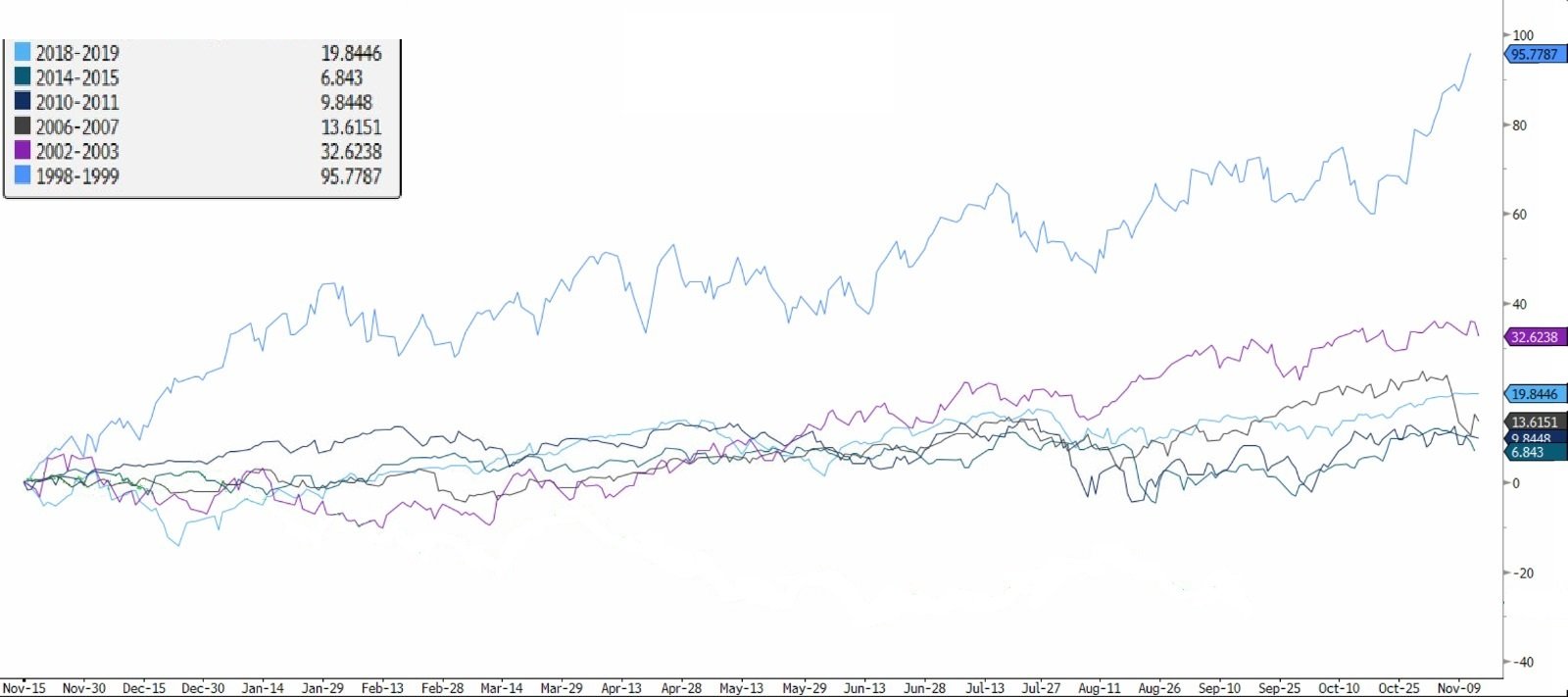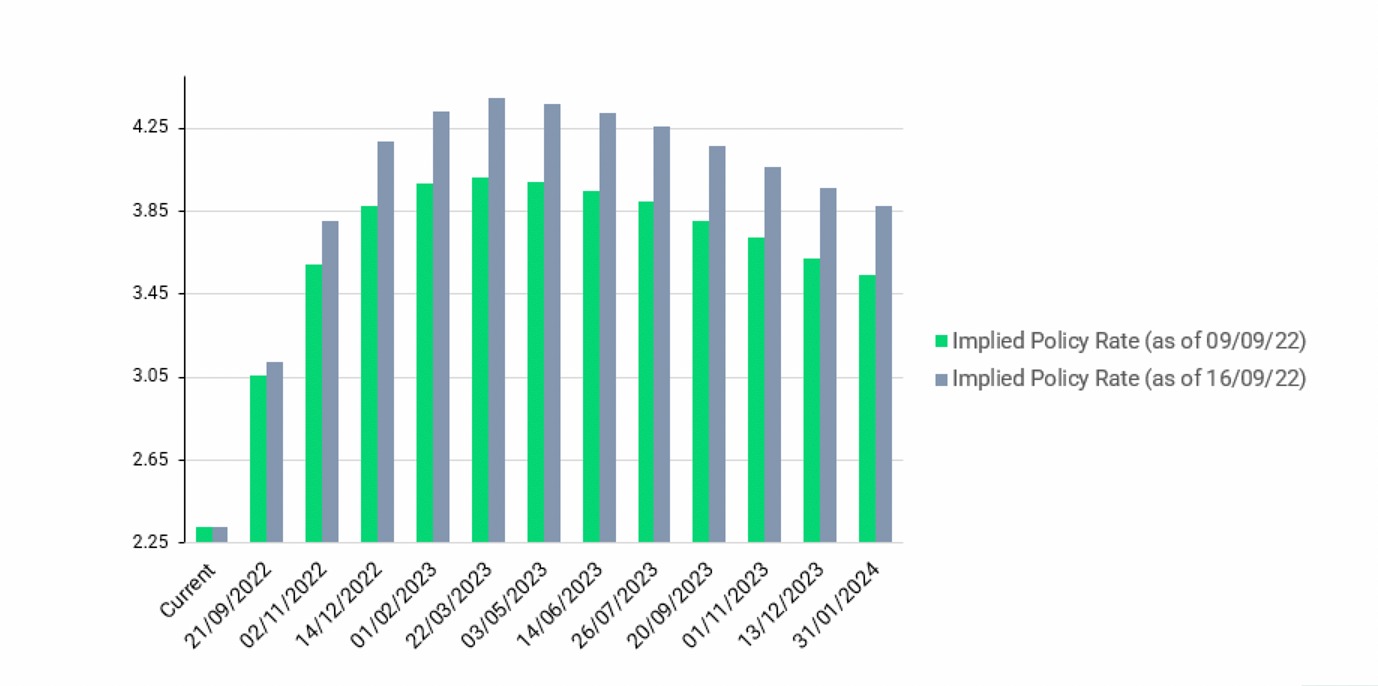Why is the Nasdaq falling?
The Nasdaq took a 5% hit last week after higher-than-expected US CPI data (8.3% vs 8.1% forecasted). The upside surprise was a discouraging read, going against the consensus view. The most striking part was the unexpected increase in core prices (ex food and energy), rising for the first time in six months.
The sticky inflation, coupled with the strength and resilience of the US economy has made some analysts change their forecasts to expect the Federal Reserve to continue to pursue its aggressive tightening. The 2-year yields, the most sensitive to Fed policy, climbed more than 30 basis points on the week to 3.87%, as traders are now discounting a terminal rate of 4.32% in April 2023, 36 basis points higher than a week earlier. And today 19th of September is about to hit 4%.
When rates rise significantly, it becomes more difficult for tech companies to meet their long-term growth expectations, and their expected future cash flows fall as the cost of money rises. This is why technology stocks in comparison to stocks in other industries are more sensitive to changes in interest rates.
Any hope of a rebound?
Inflation peaking
Inflation clearly remains a primary concern for stocks, as the market this week exhibited its fourth-harshest response to a CPI release. The US S&P500 benchmark fell 4.3%, that is 3.5 standard deviations in one day. On average, the market’s reaction to CPI prints are neutral.
However, many participants remain assured that inflation is poised to cool in the coming months, allowing the Fed to pause its rate hiking campaign. Market pricing for 5 and 10-year inflation expectations remain stable and below 2.5% at this point, and more importantly, the University of Michigan’s consumer inflation expectation, mentioned by the Fed during a previous FOMC press conference, is gradually rolling over, declining to 2.8% last month from June’s peak of 3.3%.
At the current level, we are very likely past peak headline inflation. And historically, stocks have managed to recover and advance once inflation peaks (with 2008 being an exception).
Regarding rates, it is important to remember that much of the Fed’s tightening is already priced in and we might be approaching the peak of this interest rate cycle. Moreover, there is a limit to how long high-interest rates can continue to depress the value of technology stocks, and that limit is set by the risk of a recession. Paradoxically, the arrival of a recession would be good news for the Nasdaq, as it would compel the Federal Reserve to reverse its policy.
.jpeg?width=1600&name=WhatsApp%20Image%202022-09-19%20at%2008.27.45%20(1).jpeg)
Midterm elections – a positive catalyst
Another event worth following is the upcoming midterm elections in the US. Usually, stocks tend to perform poorly ahead of midterm elections, pricing in the uncertainty of the results. But once the event is over and the results are known, stocks do well. Looking at the past two decades of Nasdaq performance 12 months after the midterm elections, the index has been up every time.
This time around, the performance could be even more significant since the index is already down nearly 30%.

Nasdaq technical analysis
The Nasdaq 100 remains above this year’s June 16 low, but the gap is narrowing and many of the tech sector’s biggest names are already making new lows. Facebook-parent Meta Platforms hit the lowest since early 2019 after tumbling 14% this week, chipmaker Nvidia and Zoom are now at the lowest in a year-and-a-half, and even Google just made new 52-week lows.
.jpeg?width=1600&name=WhatsApp%20Image%202022-09-19%20at%2008.27.45%20(2).jpeg)
Based on past Nasdaq drawdowns, we find important levels of decline. Currently, we are down 26% from the peak, while the drawdown was 30% in June of this year. A similar decline for the Nasdaq occurred in 1990 when the index fell 32%. In 1987, however, the Nasdaq 100's drawdown was stronger (-40%).
Considering a 30% drawdown from the Nasdaq peak (16’650), we reach June lows of 11’000, which last encountered offered solid support. So, chances are high that June lows would hold should prices reach that level again. However, if inflation upside surprises continue, which is not part of our base case, and we break below 11’000, then the 10’000 level is quite likely to be the next major support to look for, especially as it is a round and psychologically significant figure and corresponds to a 40% drawdown.
Conclusion
The appetite for risk has dropped significantly as uncertainty around the Fed’s inflation fight and its impact on growth has led investors to adopt a more cautious approach. The upcoming FOMC will be closely watched as any hints about future tightening will help identify where the economy and tech shares could be headed in the coming weeks. Beyond that period, we expect the end of the midterm elections to provide a positive boost to risk assets. And while some are backwards-looking, others see light at the end of the tunnel and consider recent weakness as another good opportunity to scoop up mega-cap tech stocks like Microsoft and Google at lower valuations.





